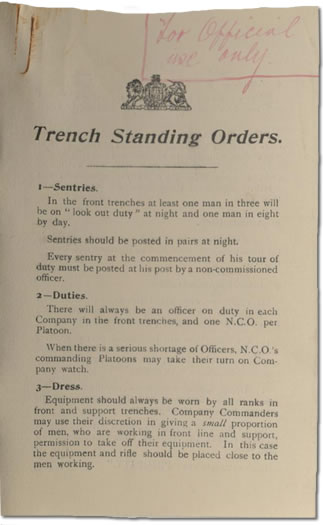
The development of trench warfareThe First World War is synonymous with the concept of trench warfare. No conflict, before or since, utilised trenches in the same way. But why did this war come to be so associated with the use of trenches? The answer lies, quite simply, with the development of high explosive artillery. By the start of the First World War, artillery pieces were able to fire further, with a greater range of accuracy, and deliver a far more powerful and destructive punch than ever before. The best protection against this onslaught was to take shelter either underground or as close to the ground as possible and so trenches started to be dug. By the end of 1915 both sides were effectively dug in in semi-permanent trench systems of increasing complexity.  First page of the Trench Standing Orders that were issued during the War. (DUL ref: Lowe Papers, File Trench Standing Orders) Although trenches were effective in providing some sort of shelter to the troops, they had many disadvantages. Not least were the awful conditions that were to be found in many of the trenches – the mud, rats, lice etc that have been so well documented. They also made attack very difficult. Traditional infantry advances were ineffective against well-defended trenches and so both sides had to find new ways of attacking each other. It is not surprising therefore, that a stalemate quickly developed in many areas. Indeed, it was not until much later in the war that the Allies were able to develop tactics that allowed them to undermine the German defences and break through the enemy lines.  Photograph of a British Trench. Taken from The Times History of the War Vol V, (DUL ref: XX+355.9403) The early trenches were reasonably simple in design and construction – long, narrow and deep. However, modifications were soon made. A direct hit on a particular part of the trench could cause massive casualties so traverses or zig-zags were introduced. Firesteps, so that the soldiers could more easily fire their rifles, also started to be built. Underground dug-outs also started to appear to provide the maximum amount of shelter for the troops. The front line trenches were accessed by communication trenches which also used a zig-zag formation to take troops and supplies from the rear to the front. As the trench systems developed, official guidance and advice started to appear. These regulations laid down almost every aspect of trench life from their design and construction to how they should be manned to how latrine duty should occur.
 Photograph of a concrete German dugout. Taken from The Times History of the War Vol V, (DUL ref: XX+355.9403) |